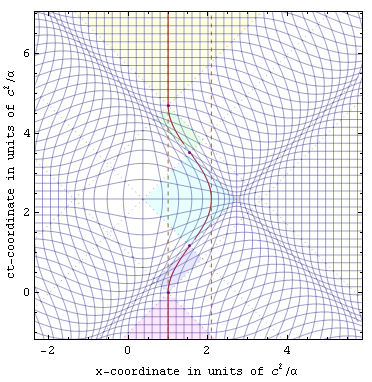File:TwentyFiveZones.png
TwentyFiveZones.png (372 × 382 pixels, file size: 94 KB, MIME type: image/png)
Captions
Captions
Summary
edit| DescriptionTwentyFiveZones.png |
English: Radar-separation hypersurfaces[1] for an accelerated traveler, defined as the average proper-time of sending/receiving a light signal to/from an event i.e. τevent = (τsend+τreceive)/2. Using the axis-labeled units, this is basically a one-gee (~1[ly/y2]) constant proper-acceleration round-trip which takes 4 traveler years to complete.
Four purple dots mark engine on/off events as well as the two mid-voyage points at which the direction of acceleration is reversed. Null trajectories extending forward and back from these points define twenty-five separate event-regions in space-time. These zones (marked off by faint dotted lines) have blue radar-isochrons, and radar-distance grid-lines, drawn in to characterize for events from the accelerated traveler perspective. Separations in this case are at intervals of 0.2 (years or lightyears) from the traveler's radar-perspective. The two vertical dashed lines (brown) represent the world lines of home and destination sites that are stationary in the x-ct coordinate system here. Following the separation between start and return isochrons into the flat-space region to the right will allow you to measure the triptime elapsed on the traveler's clocks using the ct-axis calibration here. |
| Date | |
| Source | Own work |
| Author | P. Fraundorf |
Added notes
editThe figure below compares the radar-time definition of extended-simultaneity with the tangent free-float-frame defintion for a simpler case, in which the traveler (red trajectory) is undergoing constant proper-acceleration with no start or end in sight.

See also
edit- Intro kinematics note[2] on differential-aging caused by acceleration and/or by gravity.
Footnotes
edit- ↑ (December 2001). "On radar time and the twin “paradox”". American Journal of Physics 69 (12): 1257–1261. DOI:10.1119/1.1407254. (arXiv:gr-qc/0104077)
- ↑ P. Fraundorf (2012) "A traveler-centered intro to kinematics", arXiv:1206.2877 [physics.pop-ph] mobile.
Licensing
edit- You are free:
- to share – to copy, distribute and transmit the work
- to remix – to adapt the work
- Under the following conditions:
- attribution – You must give appropriate credit, provide a link to the license, and indicate if changes were made. You may do so in any reasonable manner, but not in any way that suggests the licensor endorses you or your use.
- share alike – If you remix, transform, or build upon the material, you must distribute your contributions under the same or compatible license as the original.
File history
Click on a date/time to view the file as it appeared at that time.
| Date/Time | Thumbnail | Dimensions | User | Comment | |
|---|---|---|---|---|---|
| current | 23:15, 16 May 2012 |  | 372 × 382 (94 KB) | Unitsphere (talk | contribs) |
You cannot overwrite this file.
File usage on Commons
The following 2 pages use this file:
File usage on other wikis
The following other wikis use this file:
- Usage on ca.wikipedia.org
- Usage on en.wikipedia.org
- Usage on en.wikiversity.org
- Usage on es.wikipedia.org
- Usage on fr.wikipedia.org
- Usage on mk.wikipedia.org
- Usage on pt.wikipedia.org
- Usage on ru.wikipedia.org
- Usage on sv.wikipedia.org
- Usage on uk.wikipedia.org
- Usage on zh.wikipedia.org
Metadata
This file contains additional information such as Exif metadata which may have been added by the digital camera, scanner, or software program used to create or digitize it. If the file has been modified from its original state, some details such as the timestamp may not fully reflect those of the original file. The timestamp is only as accurate as the clock in the camera, and it may be completely wrong.
| Date and time of digitizing |
|
|---|---|
| File change date and time | 13:00, 13 June 2009 |
| Horizontal resolution | 37.79 dpc |
| Vertical resolution | 37.79 dpc |
